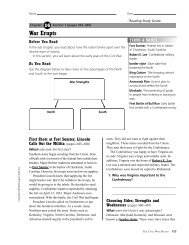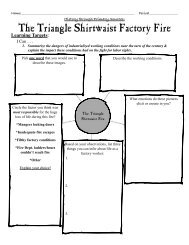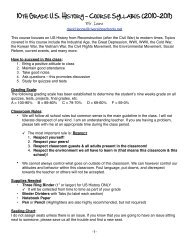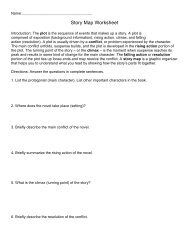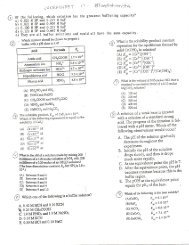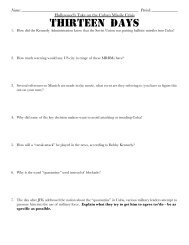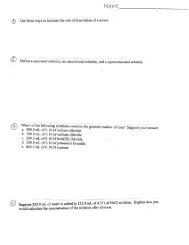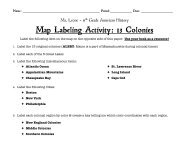Chapter 16 Text
Chapter 16 Text
Chapter 16 Text
You also want an ePaper? Increase the reach of your titles
YUMPU automatically turns print PDFs into web optimized ePapers that Google loves.
<strong>16</strong>.6 Weak Acids 633<br />
TS<br />
QJ<br />
6.0<br />
5.0<br />
N<br />
g 4.0<br />
•^ Figure <strong>16</strong>.9 The percent ionization<br />
of a weak acid decreases with increasing<br />
concentration. The data shown are for<br />
acetic acid.<br />
1 3.0<br />
i-<<br />
OJ<br />
2.0<br />
1.0<br />
0 0.05 0.10 0.15<br />
Acid concentration (M)<br />
SAMPLE EXERCISE <strong>16</strong>.12<br />
Calculate the percentage of HF molecules ionized in (a) a 0.10 M HF solution; (b) a 0.010 M HF solution.<br />
Solution<br />
Analyze: We are asked to calculate the percent ionization of two HF solutions of different concentration.<br />
Plan: We approach this problem as we would previous equilibrium problems. We begin by writing the chemical equation for the<br />
equilibrium and tabulating the known and unknown concentrations of all species. We then substitute the equilibrium concentrations<br />
into the equilibrium-constant expression and solve for the unknown concentration, that of H+.<br />
Solve: (a) The equilibrium reaction<br />
and equilibrium concentrations are as<br />
follows:<br />
Initial<br />
Change<br />
Equilibrium<br />
0.10 M<br />
-xM<br />
(0.10 - x) M<br />
0<br />
+xM<br />
xM.<br />
0<br />
+xM<br />
xM<br />
The equilibrium-constant expression<br />
is<br />
When we try solving this equation<br />
using the approximation 0.10 — x -<br />
0.10 (that is, by neglecting the concentration<br />
of acid that ionizes in comparison<br />
with the initial concentration), we<br />
obtain<br />
Because this value is greater than 5%<br />
of 0.10 M, we should work the problem<br />
without the approximation, using<br />
an equation-solving calculator or the<br />
quadratic formula. Rearranging our<br />
equation and writing it in standard<br />
quadratic form, we have<br />
[HF] 0.10<br />
-? = 6.8 X 10<br />
x = 8.2 x 10~3 M<br />
x2 = (0.10- *}(6.S X 10~4)<br />
- 6.8 X 10"5 - (6.8 x 10~4)x<br />
x2 + (6.8 x I0^}x - 6.8 X10"5 - 0<br />
This equation can be solved using the<br />
standard quadratic formula.<br />
Substituting the appropriate numbers<br />
gives " x =<br />
-6.8 x ID"1 ± V(6\ X 10~4)2 + 4(6.8 X 10~5)<br />
-6.8 X 10~4 ± 1.6 X 10~2



